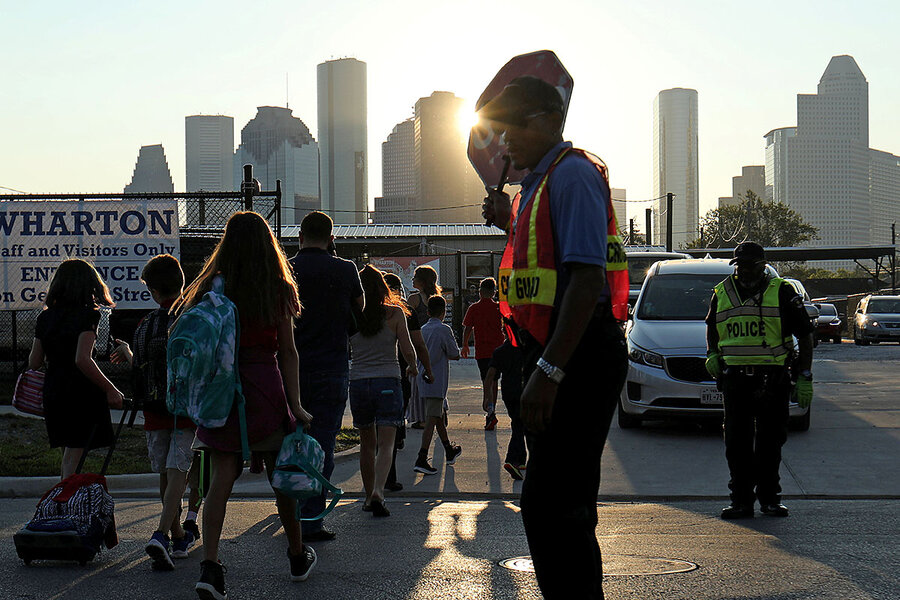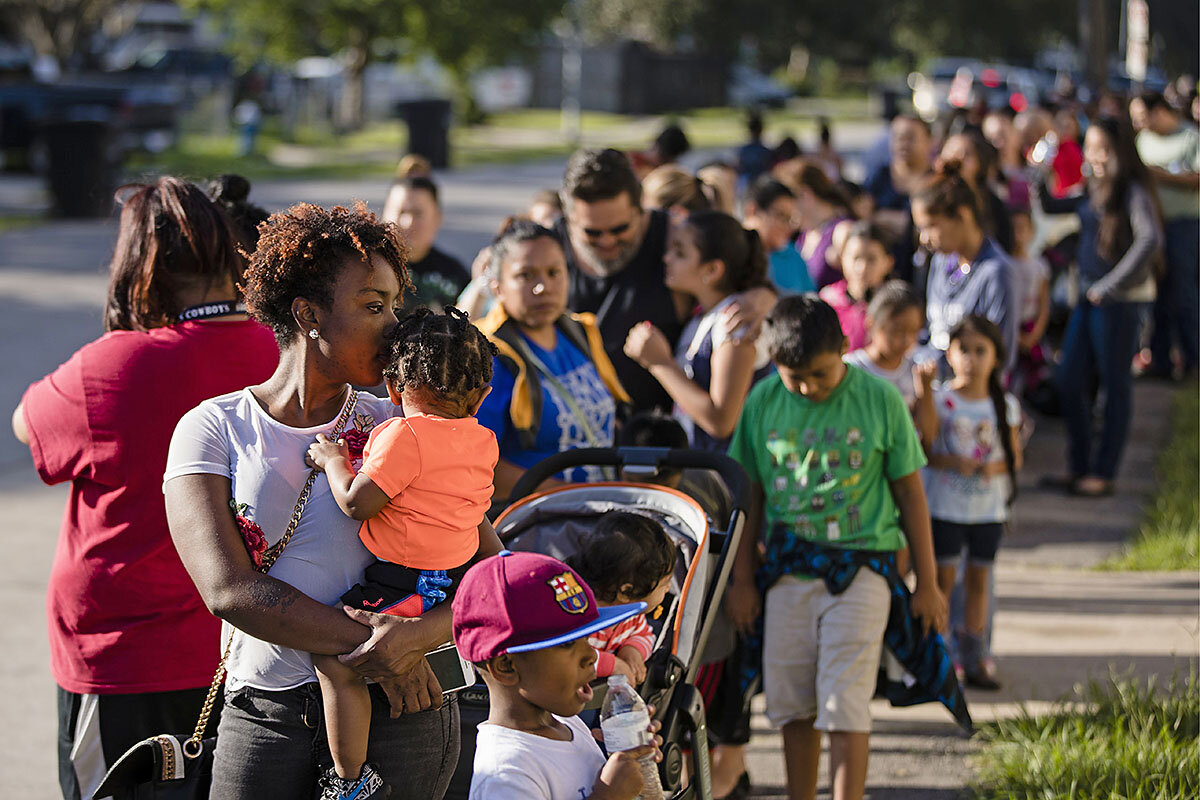Post-Katrina lessons for Harvey's returning students
Loading...
| Nashua, N.H. and Houston
Bryan McMillian was supposed to start college Aug. 28 at Prairie View A&M University, near Houston. Now, the apartment he had lined up in nearby Cypress, Texas, is flooded, and he’s trying to figure out if he can take online classes for a semester while he stays with some family in Austin.
Harvey wasn’t the first hurricane to disrupt his educational journey. Katrina hit on what would have been his first day of first grade in New Orleans. His family spent two years in Houston before they made their way back to Louisiana.
Now, six schools and innumerable life lessons later, this is what he’d say to a child displaced in Texas or, now, Florida: “Don’t let it get you down…. I know that this hurricane has caused damage…, but use this as the fuel to send you to even higher thinking and higher learning.”
He and the many adults tasked with helping children through the aftermath of disaster know that’s easier said than done. In Houston, some schools are reopening this week, while others are trying to figure out how to assist the students whose schools won’t be inhabitable anytime soon.
Staggered start dates
Houston Independent School District (HISD), the seventh-largest school district in the country and the largest district in Texas, has about 280 schools serving some 215,000 students. Given the devastation from hurricane Harvey, the district has implemented rolling start dates for many campuses, with a majority of schools starting today, and several dozen more starting next week and the week after. Included among those are seven schools that will have to have classes in alternative locations due to damage.
“To ask that kid [affected by a disaster] to show up ready to learn is a pretty big ask. Adults … have a huge responsibility to acknowledge and understand the different psychological, cognitive, and emotional effects of a disaster on students,” says Jessy Cuddy, director of culture and connections for Communities in Schools, a national network that works directly in public schools to coordinate local resources to assist at-risk students.
While the post-Harvey educational context differs from New Orleans – which experienced a mandatory evacuation, major loss of life, and a state takeover of the school system – some of the insights gained as Katrina kids have grown up can help guide school officials in both the flooded Texas districts and the districts welcoming displaced students.
For one, the number of moves a student has to make can chip away at educational progress. A report five years after Katrina noted that 34 percent of the affected middle- and high-school students were at least one grade level behind in school, compared to 19 percent of all children in the South.
They were also 4.5 times more likely than their peers nationwide to have symptoms consistent with serious emotional disturbance, according to the study, by the Children’s Health Fund, Columbia University Mailman School of Public Health, and the National Center for Disaster Preparedness.
Out of struggle, creative solutions
Many Katrina evacuees attending schools in Houston faced both academic and social struggles, such as being bullied because of the stigma attached to New Orleans when images in the media contributed to a false narrative of rampant violence and looting after the storm, says Lori Peek, co-author of “Children of Katrina” and a sociology professor who runs the Natural Hazards Center at the University of Colorado-Boulder.
On the other hand, she says, there were “some really creative things that receiving schools did in evacuee communities,… trying to treat the child in this more holistic manner so the child could learn.” Some set up buddy systems, for instance, where they matched a New Orleans newcomer with a child familiar with the school.
HISD is taking other steps, besides the rolling start dates, to make the back-to-school process easier on families. Schools will offer free breakfast and lunch to students until at least Sept. 30, as well as free dinner, but are asking parents and guardians to still apply. The school uniform policy has also been relaxed until January 2018. Students also aren’t expected to have all the necessary school supplies.
On Saturday, parents stood in line outside the Denver Harbor Multi-Service Center in north Houston for free school uniforms. One volunteer helping with the distribution, Lakshmi Kothun, says the steps HISD has taken are helping both students and parents.
“They’re being more lenient,” says Ms. Kothun, whose son is an HISD student. “I don’t think there’s any pressure on the kids’ side, [they are] just to have fun.”
“They don’t want to stay at home,” she adds. “They want to go [to school] and find out how their friends are.”
And she continues: “It gives parents time to clean up, too.”
But while HISD is taking steps to make back-to-school as easy as possible, many families are still facing an uncertain start to the school year.
Sitting on a cot in the emergency shelter at the NRG Center, a convention center, in downtown Houston last Thursday, Maria Barrios breastfeeds one of her children while admitting that she doesn’t know where her two elementary school-aged children will be going to school.
She’s registered them both for the new year, but it is unlikely she’ll be able to move back to her north Houston home any time soon. The NRG Center is miles from where her children went to school.
“Their school is so far away, they’re likely going to have to go somewhere else,” says Ms. Barrios, through a translator. “I’m really not sure just yet.”
A mixture of hardship and hope
The key for helping with transitions, says Professor Peek, is to not stereotype children as totally vulnerable or as totally resilient; they can be some of each, she says. But “they’re not like little red rubber balls. They’re not just going to bounce back without proper protections and support.”
Mr. McMillian’s story reflects that mixture of hardship and hope. He started school in Houston several months into the school year, after his family transitioned from a missionary shelter to a house.
“Most of the kids … were already learning things you would probably learn in second-, third-, or fourth-grade at home, so I was trying to catch up,” McMillian says of those early days transitioning into a first grade class. In New Orleans, he says, “I would slack off a lot and not put much effort into [school work]. But after seeing how those kids worked … I couldn’t do those things anymore. I had to learn that education is my one and only way out…. I never took my education for granted after that.”
His advice to teachers trying to help displaced students: Find something they really like doing. “It will cause them to open up more. When it comes to things they enjoy doing, it’s kind of like a safe haven or a peaceful place.”
For him, that was flag football. A Houston teacher found that out and “introduced me to the coach [for a nearby team], and he also handed me a book,” McMillian says. The book, by brothers Tiki and Ronde Barber, who both played in the NFL, “teaches you never to give up and to always keep pushing forward.”
Remember the teachers, too
In the wake of disaster, teachers need support, too, says Ms. Cuddy of Communities in Schools. “The biggest lesson out of Katrina: We asked teaches and school-support personnel and principals to go back to work the minute schools opened, and we expected them, without any processing or mental health support, to support the kids in their care…. Frankly, that’s irresponsible.”
In a question and answer section on it's website, HISD suggests that its plan for emotional support does include teachers: "HISD will have services available at schools to support the emotional needs of students and staff when they return. We are coordinating with other school districts across the region and country to help us in this effort, as we know many staff in our own district have been personally impacted by the storm."
With four siblings and a mom who had a hard time finding a job after Katrina, McMillian says, “there were some times where … in my head I would be like, this isn’t fair, my friends have this and I don’t…. Sometimes you have to go through struggles to really find the light within those.”
At school, he says, friends would help just as he was on the verge of giving up.
He returned to Louisiana and eventually to New Orleans, where he attended several schools before graduating from Landry-Walker High School earlier this year. The Urban League’s Project Ready program there enabled him to earn an electrical certificate through dual enrollment in the high school and a community college. He also helped his aunt build a community center in New Orleans, sparking his desire to study electrical engineering.
An image from the book “Esperanza Rising,” by Pam Muñoz Ryan, has stuck with him – the symbolism of the stitching of a quilt. “Our lives are the needle and the string that’s going through,” he says. “And Harvey is basically us going through and down. But you have to pick yourself back up, and go through, over and up.”








